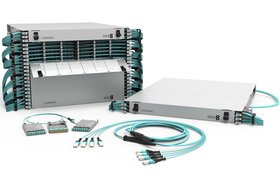We’ve all heard how fiber is taking center stage in the ongoing work of bringing high-speed connectivity to homes, businesses, and communities. But what many people may not realize is that fiber is also playing a pivotal role in another fast-moving technology trend: artificial intelligence (AI).
We are at a moment when AI is becoming integral to a wide range of industry sectors. Some of these applications are in use right now, but many others are in their infancy or even yet to emerge – and all have the potential to change our lives.
- Healthcare: In the field of healthcare, AI can help clinicians in their life-saving work by helping detect abnormalities in medical imaging, or analyzing data to help oncologists make more sophisticated data-driven decisions for cancer treatment.
- Educators: Can customize content to individual student performance. For example, AI-driven tutoring systems can adapt to students' strengths and weaknesses and offer personalized guidance.
- Manufacturing: On the factory floor, manufacturers can leverage AI tools to inspect and identify defects in real time.
- Finance: AI can help protect against unauthorized transactions and provide new analytical tools for portfolio management.
- Traffic flow: If you get stuck in traffic on a regular basis, you can appreciate how AI holds the potential to dramatically improve traffic flow through AI-enabled systems that align signals with current conditions, reducing congestion and improving the overall flow of traffic.
- Quantum computing: Is unlocking still more possibilities in the realm of generative AI, as quantum computers can process a vast number of possibilities simultaneously. This could potentially speed up AI algorithms and process larger data sets more efficiently, leading to more powerful AI models.
All this growth in AI capabilities is just starting to accelerate. Consider ChatGPT, and its successive transformations in just the last few years.
It was in 2020 that GPT-3 arrived on the scene, with far more extensive capabilities than earlier versions. The original GPT, introduced in 2018, had 117 million parameters (which are the learnable elements of the model during the training process), while GPT-3 was introduced with 175 billion, making it one of the largest language models in existence, representing a substantial leap in scale and capability. The following year, Dall-E was released to enable converting text to image.
Then in November 2022, ChatGPT was released to the public – and to say it attracted a lot of attention would be an understatement. Two months later it had reached 100 million users, and by February 2023 it had reached over a billion users. In March, we saw the release of GPT-4, which significantly improved ChatGPT’s capabilities.
Now this growth in users and new applications is driving the number of high-powered processors, called Graphical Processor Units (GPUs), per machine up significantly – and we expect several million GPUs to be deployed by the end of 2024.
So, what's happening within the data center to enable both cloud and AI computing?
Let’s start with traditional cloud compute and what we’re familiar with. Typically, hyperscale data center operators build a campus and interconnect it with high-fiber-count single-mode cables. These cables often contain more than 3,000 fibers.
Then, this fiber comes inside the data center and routes to spine and leaf switches that are meshed together, creating an incredible number of optical links and connections to traditional processors (CPUs) located in server racks throughout the data center. When done correctly, these networks enable familiar uses like streaming movies or surfing on social platforms.
Now, to enable an AI data center network, clusters of powerful servers with many GPUs are needed that require a high number of connections. This AI cluster is then connected back to the primary network and routed appropriately. And the amount of electrical power to fire up the AI server clusters is significantly more than on the front end for the comparable number of servers.
We’re seeing leading hyperscalers designing and beginning to build data centers with this second optical AI network, which is increasing optical connections by up to five times within data centers.
As our teams here at Corning work with our hyperscale data center customers to meet the requirements of an AI data center, we’re focusing on innovation guided by the 4S principles, speed, simplicity, size, and sustainability. Those key vectors are as important in the data center space as they are in the access network:
- Speed: We have heard from data center operators that speed to build is the number one challenge they are facing. AI is happening much faster than anyone expected, and the race is on. By bringing field labor challenges into our factories with plug-and-play preterminated assemblies, we’re able to create significant time savings.
- Simplicity: Preterminated solutions also mean simpler installation in the field – a critical factor given the current constraints on skilled labor. This is familiar territory in building an FTTH network, where these solutions enabled major operators to scale their deployments significantly.
- Size: The data center optical footprint, measured in size and density, is critical given the increased number of optical connections. For instance, our recent engagements with one operator indicated a 1:1 ratio of server racks to optical patching racks. This means valuable real estate in a data center is consumed with racks full of patch panels and not revenue generating servers. That’s where new smaller, denser solutions matter.
- Sustainability: Shrinking the entire optical footprint naturally creates a sustainability benefit by using less materials. We believe our latest generation of data center innovations provides up to a 55 percent reduction in carbon footprint.
To create these benefits, the industry is using new keystone infrastructure components that include:
- New, smaller fibers: An example is our new 190-micron Corning SMF-28 Contour fiber, which is 20 percent smaller than our 242-micron diameter fiber. It also delivers superior bendability and low signal loss.
- Denser cables: The new fibers enable a cable revolution – with the ability to create much higher cable density. That means higher fiber counts in a smaller cable diameter, or a smaller cable with the same number of fibers.
- Connectivity innovations: The new MMC connector that miniaturizes multifiber termination connectivity can increase the fiber density in a housing by up to three times over a traditional MTP connector. This optimizes valuable real estate within a data center by minimizing the optical footprint.
Bottom line: The demand for artificial intelligence changes the game for data centers. Emerging AI data center network architectures represent a step change in passive optical content in the data center – and at Corning, we’re excited to be working with the world’s largest hyperscale data centers to lay the fiber-rich foundation required for AI data center operations.
And just as importantly, we see this trend being a game-changer in the access network. To use this powerful compute capability, it requires high bandwidth networks that enterprises and consumers can access to realize AI’s potential. So the work our industry continues to do to get the world connected is even more critical to ensure nobody gets left behind.
This blog is adapted from a recent presentation by O’Day to the Fiber Broadband Association as part of its ‘Fiber For Breakfast’ series.
More from Corning
-

How fiber-rich interconnects help data centers meet the processing demands of AI
Data center operators must plan for a new processing model in order to maximize potential of AI
-

Connectivity: From land, to sea, to space
An eBook examining the crucial role of connectivity - no matter where we are
-

Sponsored Fast mover: Managing rapid growth in the data center
Demand for data has been doubling every couple of years – or sooner – for the past three decades. What can data center operators do to keep pace?

